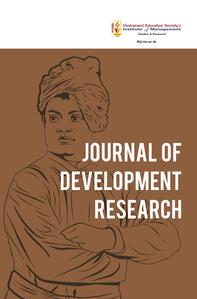
1MET IOM, Mumbai, Maharashtra, India

Creative Commons Non Commercial CC BY-NC: This article is distributed under the terms of the Creative Commons Attribution-NonCommercial 4.0 License (http://www.creativecommons.org/licenses/by-nc/4.0/) which permits non-Commercial use, reproduction and distribution of the work without further permission provided the original work is attributed.
The COVID-19 pandemic significantly disrupted all aspects of human life during 2020 and 2021, leading to widespread remote work due to strict restrictions aimed at controlling the virus’s spread. This shift affected various industries, including software development, where many teams transitioned to remote work and adopted hybrid project management methodologies. Combining Agile with waterfall approaches helped address the new challenges posed by remote collaboration and communication barriers. The research article concentrates on the impact of COVID on Agile values.
Agile, pandemic, COVID-19, Agile software development, questionnaire, remote working, AI Powered Agile, project management, Agile Manifesto
Introduction
The COVID-19 pandemic, which spanned across 2020 and 2021, profoundly impacted every facet of human life as countries around the world implemented strict measures to curb the spread of the virus. These restrictions led to significant shifts in how people work, live, and interact. One of the most notable changes was the widespread adoption of remote work. With lockdowns and social distancing measures in place, many industries had to transition to working from home to maintain operational continuity. This shift not only altered daily routines but also forced companies to adapt quickly to new tools and methods to support remote collaboration.
Among the various sectors affected, the software industry saw a notable shift in its project management practices. Traditionally, many software development teams adhered to Agile methodologies, which emphasise iterative progress and flexibility. However, the pandemic accelerated the adoption of hybrid approaches that combine Agile with traditional Waterfall methodologies. This hybrid model was introduced to address the unique challenges posed by remote work, such as communication barriers and project management complexities. As a result, teams had to balance the iterative nature of Agile with the structured planning of Waterfall to ensure project success despite the disruptions caused by the pandemic.
Aim or Need for the Study
Literature Review
What is Agile?
Agile project management and software development is an iterative method that helps teams offer value to clients faster and with fewer headaches. An Agile Team delivers work in tiny, digestible increments rather than relying on a ‘big bang’ launch. Teams have a natural mechanism for adjusting to change fast because requirements, strategies, and results are evaluated on a regular basis (What is Agile? | Atlassian, 2022).
What is Agile Manifesto?
We are uncovering better ways of developing software by doing it and helping others do it. Through this work we have come to value:
Individuals and interactions over processes and tools
Working software over comprehensive documentation
Customer collaboration over contract negotiation
Responding to change over following a plan
That is, while there is value in the items on the right,
we value the items on the left more.

(Manifesto for Agile Software Development, 2001).
The Agile Manifesto is a statement of the basic values and principles of Agile software development. The Manifesto for Agile Software Development, as it is officially known, attempts to have an effective model for teams to accomplish goals the Agile project management concept and apply it to better their work process. The Agile Manifesto’s minimalistic architecture was created to improve on past software development procedures that were more complex and involved a lot of documentation. The founding members sought to make these processes faster and build a more efficient teamwork approach. Essentially, the Agile Manifesto is a software development approach that is a replacement for traditional software development approaches.
What are Agile Frameworks?
An Agile framework is a method for planning, managing, and completing projects. Agile frameworks are usually divided into two types: (Berman, n.d.).
There is no one-size-fits-all Agile framework. The ideal approach for your team or organisation will be determined by a number of parameters, including your sector, Agile readiness, the number of Agile teams, and overall Agile targets.
The most common Agile frameworks below, as well as provide resources to assist you in selecting the best Agile process fits your purposes (Berman, n.d.).
Team Level
Scrum
The scrum framework for teams is one of the most well-known Agile frameworks. Scrum is defined as ‘a framework within which people can address complex adaptive challenges while producing and delivering solutions of the highest possible value’, according to the Scrum Guide. Scrum is designed to be lightweight and simple to grasp by definition.
Some may argue, however, that mastering it is tough. The use of time-boxed iterations is the most identifiable aspect of scrum: Scrum teams work in sprints, which last anything between two and four weeks. Sprinting allows teams to deliver swiftly and predictably while remaining flexible enough to pivot as needed (Berman, n.d.).
XP
Another team-level Agile paradigm with roots in software development is Extreme Programming (or XP). XP, like most Agile methodologies, provides for frequent releases in short development sprints that encourage change as necessary. XP is less regulated than many Agile frameworks, and instead of steps, it embraces a set of morals. The following are some of XP’s values and principles:
Developers must first design and comprehend the customer’s user stories—informal descriptions of features and feature requirements—in order to implement Extreme Programming (Berman, n.d.).
Kanban
Kanban is a Japanese word that means ‘visual signal’ or ‘card’. Although Kanban has its origins in manufacturing, it has been widely used to software development and other sorts of knowledge work. Kanban is a popular technique among Lean and Agile teams, and it may be integrated into other Agile frameworks. Kanban is a popular technique among Lean and Agile teams, and it may be integrated into other Agile frameworks. Physical or digital boards are used to depict a team’s or organisation’s unique approach in this methodology more efficiently and with better agility. Kanban is a popular technique among Lean and Agile teams, and it may be integrated into other Agile frameworks (Berman, n.d.).
Scrumban
Scrumban is an Agile framework that combines Scrum and Kanban. It was created to fulfil the demands of teams who wanted to reduce batching and embrace a pull-based system. This Agile framework, which combines parts of Scrum and Kanban, allows teams to react to stakeholder and production needs without feeling overloaded by their project methodology. Scrumban can also be employed as a bridge between Scrum and Kanban for teams transitioning from Scrum to Kanban. Scrumban allows teams can learn how to use Kanban to perform constant improvement without sacrificing the scrum structure (Berman, n.d.).
Scrum of Scrums
Scrum of Scrums intends to expand on scrum’s team-level concepts while also allowing enterprises to interconnect several scrum teams that need to work together to produce complicated solutions. Regardless of the fact that Scrum of Scrums is an approach for spreading scrum over numerous teams, it is not considered one of the actual scaling Agile frameworks because it lacks the concrete guidance required to scale Agile across an organisation. This method can assist teams in balancing small team numbers and the need to develop complicated products. Complex goods (or services) necessitate the collaboration of several cross-functional teams. Scrum of Scrums enables enterprises to scale the success of their present scrum teams without having to change their procedures dramatically (Berman, n.d.).
Organisation Level (Scaling Agile)
SAFe-Scaled Agile Framework
It is one of several Agile frameworks meant to help businesses scale Agile beyond individual teams. Many team-level Agile techniques are incorporated into SAFe. SAFe, in particular, assists large businesses in navigating the obstacles of deploying, extending, and employing Agile techniques and practices across various teams and departments.
SAFe was built by and for practitioners, based on three main sources of knowledge:
SAFe is a systematic strategy that helps organisations achieve alignment, improve cooperation, increase flexibility, and increase predictability across many Agile teams (Berman, n.d.).
Disciplined Agile
Disciplined Agile (DA) is a lightweight Agile methodology that helps teams practise Agile at scale. DA is often thought of as a combination of XP, scrum, Kanban, and other Agile frameworks because it promotes a ‘people-first’ approach to Agile. Because it does not teach basic Agile ideas or practices, DA is best suited for organisations that are already familiar with them. DA, on the other hand, might be a winning technique for established Agile organisations looking for a lightweight, hybrid scaling solution (Berman, n.d.).
Large Scale Scrum
Scrum is a real team-based Agile paradigm, with minimal direction on how to scale to several teams. Many teams find scrum to be effective and want to scale it without losing the aspects of scrum that have proven to be effective. LeSS (Large Scale Scrum) might be a useful Agile framework for these teams. LeSS adapts the scrum fundamentals to work with many teams. LeSS works well when all of the teams involved are working on the same product or value stream, but it is not the proper Agile framework for a company wanting to grow Agile throughout its portfolio (Berman, n.d.).
Nexus
Nexus is another Agile framework that draws on the scrum foundations. It stresses minimising and managing dependencies amongst scrum teams as a road toward agility, and it is intended for building and maintaining product delivery projects at scale. Nexus refers to a group of three to nine scrum teams working together to develop a single product in this scaled Agile methodology. Each Nexus has a single product owner who is in charge of the Product Backlog for that Nexus. Nexus’ creators are adamant about sticking to the basic elements of scrum, expanding the scope of scrum only when it allows several scrum teams to collaborate on a project (Berman, n.d.).
Spotify Agile
Spotify, the audio streaming platform, is credited with introducing many people to Agile, to the point where a particular version of Agile that they originally used and popularised is known as the Spotify Model. The Spotify Model is a self-contained, people-driven approach to Agile scaling. It’s not so much a framework as it is a great example of Agile at scale from a technical standpoint. Spotify engineers described their method to scaling Agile (in the now-famous document scaling Agile @ Spotify) and shared it with the world, and many organisations have tried to emulate it since. Many Agile thinkers, including the author of Scaling Agile @ Spotify, have concluded that the Spotify Model is essentially a pre-Scrum@Scale (S@S) version of Scrum (Berman, n.d.).
Scrum@Scale
S@S, another Agile framework meant to help organisations implement Scrum (you guessed it!) at scale, is credited to Jeff Sutherland, a well-known Agile expert who created the Scrum Guide. S@S incorporates aspects of: (Berman, n.d.).
What is Agile Project Management?
Agile project management is an incremental method of project delivery that takes place across the course of the project’s life cycle. Iterative or Agile life cycles are made up of multiple iterations or incremental steps that lead to a project’s completion. Because iteration allows you to alter as you go instead of pursuing a straight path, iterative approaches are frequently employed in software development projects to promote velocity and adaptability.
An Agile or iterative strategy strives to deliver benefits throughout the process rather than just at the end. Trust, adaptability, empowerment, and cooperation should all be essential ideals and attitudes in Agile initiatives (Agile project management, n.d.). The difference between the Agile and Traditional approaches can be understood in a better way with the help of below Figure 1.
What is Agile Team?
In the Agile concept, a ‘team’ is a small group of people who are all working on the same initiative or endeavour full-time. A small percentage of team members may work part-time or have competing responsibilities. The concept of a team implies shared accountability: whether the results are positive or terrible, they should be credited to the entire group rather than any single person. The team is expected to have all of the required skills, whether they are technical (programming, design, testing) or business-related (domain knowledge, decision-making ability). Results matter more than roles and responsibilities: a developer can test, analyse, or think about requirements; an analyst or domain expert can offer implementation ideas, and so on (What is an Agile Team? n.d.).
Figure 1. Diagram Source: Directing Agile Change.
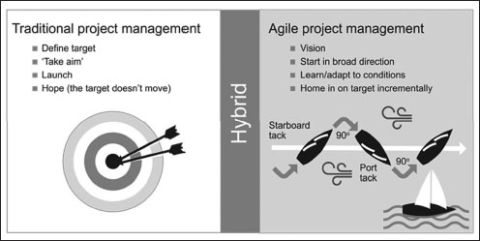
When utilising the scrum framework, for example, an Agile Team should contain a scrum master, a product owner, and any additional team members who are required. The scrum master (sometimes referred to as the project manager) is in charge of overseeing the project, facilitating collaboration, and coordinating daily meetings. The product owner is in charge of making sure that the finished version fits the customer’s needs. Subject matter experts and other stakeholders may be brought in to help with the project as needed, but they are not usually considered members of the Agile Team (What Is an Agile Team? n.d.)
What are Agile Ceremonies?
The Agile Scrum paradigm, according to the 2020 Scrum Guide, includes five major ceremonies:
Within the software development lifecycle, each ceremony plays a key role in increasing outputs and generating value (SDLC). There’s one more ceremony to mention: the unofficial ‘Product Backlog Grooming’ ceremony, which takes place during the Sprint and is an important part of scrum methods. To help eliminate complexity and extra meetings not stipulated in the scrum approach, all ceremonies should be conducted at the same time and in the same location
Figure 2. Scrum Framework.

Source: Santos, 2022.
Collaboration is highly valued in Agile, and this is not exclusive to Scrum. There are Kanban ceremonies such as cadences and Lean ceremonies such as kaizen events, for example. Any Agile strategy should include interaction, cooperation, and constant feedback. Finally, these techniques allow teams to deliver products that are both faster and higher quality (Santos, 2022). Figure 2 explains the scrum framework with its components.
What is Pandemic-COVID 19?
The SARS-CoV-2 virus causes Coronavirus Disease (COVID-19), an infectious disease.
The majority of those infected with the disease will have mild to moderate respiratory symptoms and will recover without the need for medical attention. Some, on the other hand, will become critically unwell and require medical assistance. Serious sickness is more likely to hit the elderly and those with underlying medical disorders such as cardiovascular disease, diabetes, chronic respiratory disease, or cancer. COVID-19 can make anybody sick and cause them to get very ill or die at any age.
Being thoroughly informed on the disease and how it spreads is the best strategy to avoid and slow down transmission. Stay at least 1 metre away from people, wear a well-fitted mask, and wash your hands or use an alcohol-based rub periodically to protect yourself and others from infection. When it’s your turn, get vaccinated and follow local advice.
When an infected individual coughs, sneezes, speaks, sings, or breathes, the virus spreads in microscopic liquid particles from their mouth or nose. Larger respiratory droplets to smaller aerosols are among the particles. If you are sick, it is critical to adopt respiratory etiquette, such as coughing into a flexed elbow, and to stay at home and self-isolate until you heal (Coronavirus, 2019).
How Agile Team Work Changed During Pandemic?
COVID-19 has ushered in the concept of a new normal, which has fundamentally altered our way of life. Masks are now worn, social and physical distance is practised, and many of us work from home. According to Forbes, the number of Americans working from home has surged from 3.4% to 42% in the last year. This number is sure to rise, as 65% of Americans say they do not want to return to their previous employment.
Many businesses and organisations have been compelled to modernise and develop new ways to conduct business as a result of the pandemic. Before COVID-19, for example, few people had heard of video conferencing software. Most of us now make video calls with Zoom, Skype, Teams, or FaceTime on a routine basis. A number of different capabilities have been added to the mix like Google Meetings and Zoom to assist accommodate and facilitate the influx of interactions required during conference calls. Instead of a whiteboarding session in a conference room, we now have Miro or Figma, which have risen in popularity due to their capacity to facilitate remote collaboration.
Organisations appear to be adapting and conquering this ‘virtual hurdle’, but is this at the expense of the Agile doctrine?
No, is the quick response. Agile has remained the same and will continue to do so. Adaptability, understanding how to make changes, when to make them, and how to communicate them are all critical in this new distant world, whether it’s Kanban, Scrum, Extreme Programming (XP), SAFe®, or even Dynamic System Development Method (DSDM) (Agile ways of working in a post-pandemic world of remote work - YourDigitalAid, 2022).
Digital.ai performed a quick follow-up survey of responders in mid-May 2020 to discover more about how the COVID-19 epidemic has impacted their Agile adoption (Report, 2020). In addition, 55% of respondents said their organisation aims to enhance Agile adoption in the next 12–14 months. This is up 13% from the original study, which was performed just five months earlier.
Over the last 90 days, 43% of firms think their Agile adoption momentum has grown, with 15% stating it has increased significantly. In the previous 90 days, 33% indicate they have enhanced or expanded their Agile implementation to help manage distributed teams.
As mentioned in Mckinsey Report, Jadoul et al. (2020) in adjusting to COVID-19, Agile enterprises have outpaced others. They have accelerated their work and responded to new industry environments by reviewing their priorities and employing strategies such as objectives and key results (OKRs). Agile teams’ weekly and daily rhythms have proven to be effective in remote contexts. Leaders can use performance and health tracking tools to get a sense of how well and swiftly things are going and where they should focus their efforts.
Identification of Variables
The variables identified are:
Developing Theoretical Construct and Hypothesis
Based on the literature review and the variable identified the below hypothesis is formulated
Hypothesis 1:
H0: There is no impact of pandemic on the value of Individuals and interactions over processes and tools of Agile Manifesto
Ha: There is negative impact of pandemic on the value of Individuals and interactions over processes and tools of Agile Manifesto
Hypothesis 2:
H0: There is no impact of pandemic on the value of Working software over comprehensive documentation of Agile Manifesto
Ha: There is negative impact of pandemic on the value of Working software over comprehensive documentation of Agile Manifesto
Hypothesis 3:
H0: There is no impact of pandemic on the value of Customer collaboration over contract negotiation of Agile Manifesto
Ha: There is negative impact of pandemic on the value of Customer collaboration over contract negotiation of Agile Manifesto
Hypothesis 4:
H0: There is no impact of pandemic on the value of Responding to change over following a plan of Agile Manifesto
Ha: There is negative impact of pandemic on the value of Responding to change over following a plan of Agile Manifesto
Methodology
It is primary research. The research article is based on literature review, case studies and surveys of different software companies to understand how these new COVID restrictions and practices impacted their day-to-day practices, their perceptions about Agile Manifesto and how new and emerging technologies can be leveraged for better management and outcome from Agile framework. It was then followed by conducting an online survey. The questionnaire was filled out by respondents using Google Forms and data was collected in data sheet for further analysis on impact of COVID on value of Agile Manifesto by formulating hypothesis for each value.
The JASP software was used for data analysis and hypothesis testing for performing chi-square tests.
Sample Design
Simple random probabilistic sampling is used. The sample size for the small survey was determined using Andrew Fisher’s Formula (Kibuacha, 2021).
Using the above formula with confidence interval of ±10% and 95b% confidence level with a z-score of 1.960, the sample size planned was 96 (Figure 3).
Questionnaire Design
There was a total of 15 questions in the questionnaire. The questionnaire is designed using Google Forms with four sections, General information (7)- as multiple choice, Agile Adoption (2)- as multiple choice, Agile Manifesto (4)- As rating scale from 1 to 5 and 1 Open question on how AI can help 2)- 1 Yes-No and one open end question.
Tools and Techniques for Data Analysis
The data is collected with the help of an online survey which was saved in Google Sheets as a part of survey response.
JASP software is used for percentage calculations, chi-square tests, and reliability testing. To quantify reliability, Cronbach’s alpha is used.
Results and Discussions
Seventy-eight responses came from the questionnaire against 96 planned. The demographics of respondents are as follows
From the above Figure 4, we can conclude that, among the people who responded, 73% are men and 27% are women.
As per Figure 5, among the people who responded majority one is at the age group of 26–35 years with 6–10 years of experience working majorly in IT Services with Team Lead role who has to drive people with Agile ideologies and Agile culture to function the team with high productivity and efficiency.
Figure 3. Andre Fisher’s Formula.

Source: Jung, 2014.
Figure 4. Gender Wise Distribution.
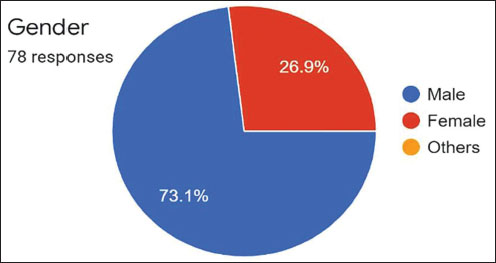
Figure 5. Age, Role, Experience and Sector Wise Demographics.

Figure 6. Adoption of Agile Frameworks.
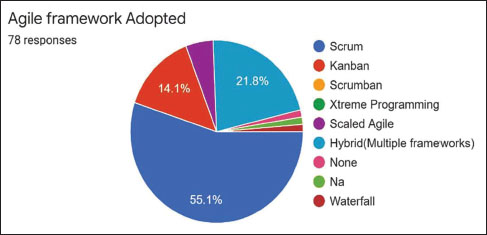
Figure 7. Word Cloud on Open-end Question.

Table 1. Statistics on Frequency Scale Reliability.

From Figure 6, it can be concluded the scrum framework which is a team-level framework majorly followed, the Agile values at the team level and the style of working is more prominent at the team level than that of organisation level.
Reliability of Data
The collected data to prove the hypothesis has acceptable internal consistency as Cronbach’s Alpha test is performed and α = 0.87, refer Table 1, the acceptable value is above 0.7.
Each hypothesis is tested using chi-square method with rating for each Agile Manifesto values with respect to sector, Experience and role. Please find the contingency table below.
Hypothesis 1:
H0: There is no impact of pandemic on the value of Individuals and interactions over processes and tools of Agile Manifesto
Ha: There is negative impact of pandemic on the value of Individuals and interactions over processes and tools of Agile Manifesto
Sector Wise
Table 2. Contingency Tables.
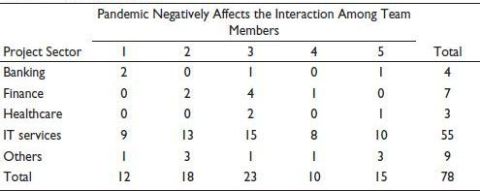
Table 3. Chi-squared Tests.

Role Wise:
Table 4. Contingency Tables.
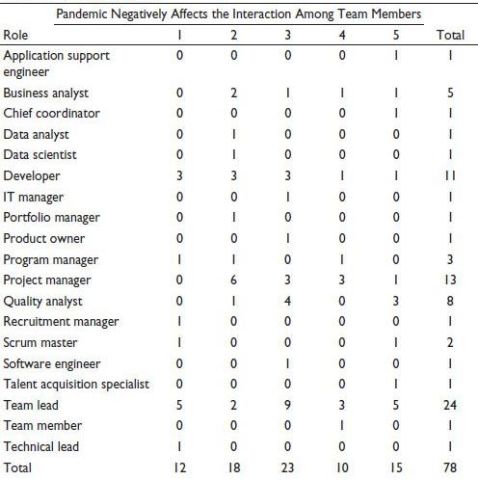
Table 5. Chi-squared Tests.

Experience Wise
Table 6. Contingency Tables.

Table 7. Chi-squared Tests.

Post analysing the above data (from Table 2, Table 3, Table 4, Table 5, Table 6, Table 7) the p value is greater than .05, which concludes that null hypothesis (H0) is true, so we accept H0 and reject alternate hypothesis (Ha)and There is no impact of pandemic on the value of Individuals and interactions over processes and tools of Agile Manifesto
Hypothesis 2:
H0: There is no impact of pandemic on the value of Working software over comprehensive documentation of Agile Manifesto
Ha: There is negative impact of pandemic on the value of Working software over comprehensive documentation of Agile Manifesto
Sector Wise
Table 8. Contingency Tables.
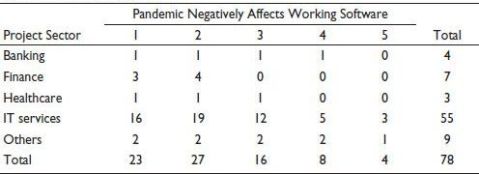
Table 9. Chi-squared Tests.

Role Wise
Table 10. Contingency Tables.
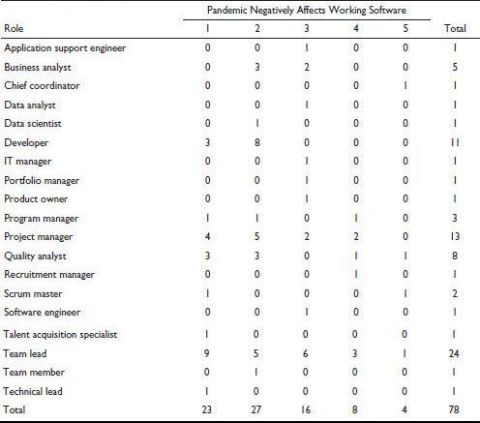
Table 11. Chi-squared Tests.

Experience Wise
Table 12. Contingency Tables.

Table 13. Chi-squared Tests.

Post analysing the above data (from Table 8, Table 9, Table 10, Table 11, Table 12, Table 13) the p value is greater than .05, which concludes that null hypothesis (H0) is true, so we accept H0 and reject alternate hypothesis (Ha) and There is no impact of pandemic on the value of Working software over comprehensive documentation of Agile Manifesto
Hypothesis 3:
H0: There is no impact of pandemic on the value of Customer collaboration over contract negotiation of Agile Manifesto
Ha: There is negative impact of pandemic on the value of Customer collaboration over contract negotiation of Agile Manifesto
Sector Wise
Table 14. Contingency Tables.
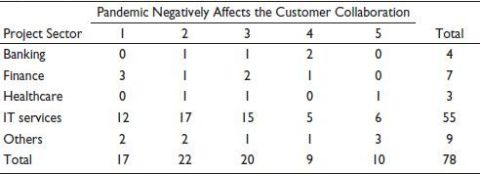
Table 15. Chi-squared Tests.

Role Wise
Table 16. Contingency Tables.
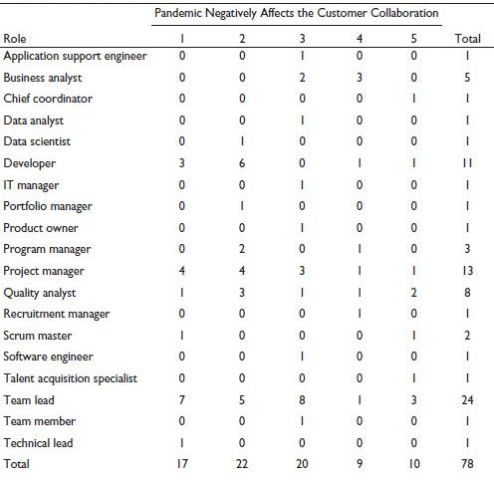
Table 17. Chi-squared Tests.

Experience Wise
Table 18. Contingency Tables.

Table 19. Chi-squared Tests.

Post analysing the above data (from Table 14, Table 15, Table 16, Table 17, Table 18, Table 19) the p value is greater than .05, which concludes that null hypothesis (H0) is true, so we accept H0 and reject alternate hypothesis (Ha)and There is no impact of pandemic on the value of Customer collaboration over contract negotiation of Agile Manifesto
Hypothesis 4:
H0: There is no negative impact of pandemic on the value of Responding to change over following a plan of Agile Manifesto
Ha: There is negative impact of pandemic on the value of Responding to change over following a plan of Agile Manifesto
Sector Wise
Table 20. Contingency Tables.

Table 21. Chi-squared Tests.

Role Wise
Table 22. Contingency Tables.
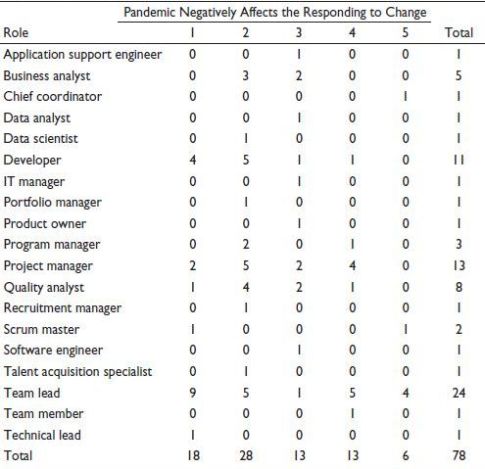
Table 23. Chi-Squared Tests

Experience Wise
Table 24. Contingency Tables.

Table 25. Chi-squared Tests.

Post analysing the above data (from Table 20, Table 21, Table 22, Table 23, Table 24, Table 25) the p value is greater than .05, which concludes that null hypothesis (H0) is true, so we accept H0 and reject alternate hypothesis (Ha)and There is no impact of pandemic on the value of Responding to change over following a plan of Agile Manifesto.
Conclusion
Managerial Implication
Based on the literature review and the survey conducted below are the actions to be taken
Limitation
Contribution of Research
Acknowledgements
I would like to extend my sincere gratitude to Dr. Nirmala Joshi for her invaluable guidance and insightful feedback throughout the development of this research. Her expertise and constructive criticism greatly enhanced the quality of this study. Special thanks to the staff at the MET Institute for their assistance with the experimental setup. I am also grateful to my fellow PhD students for their thoughtful discussions and feedback. Finally, I would like to acknowledge the emotional support of my friends and family, who encouraged me throughout the research process.
Declaration of Conflicting Interests
The authors declared no potential conflicts of interest with respect to the research, authorship and/or publication of this article.
Declaration of Originality
We confirm that this manuscript is an original work and has not been previously published or submitted elsewhere. We have adhered to all academic standards of originality and plagiarism-free writing. Any previously published work referenced has been cited appropriately.
Ethical Declaration
The authors declare that there were no ethical violations, and all procedures involving human participants were carried out with their welfare and rights in mind.
Funding
The authors disclosed receipt of the following financial support for the research, authorship, and/or publication of this article: The given research is self-funded.
ORCID iD
Samruddhi Shetty  https://orcid.org/0000-0003-0619-7935
https://orcid.org/0000-0003-0619-7935
Agile Alliance | n.d. What is an Agile Team? [online] Retrieved April 24, 2022, from https://www.agilealliance.org/glossary/team
Agilemanifesto.org. (2001). Manifesto for Agile Software Development. [online] Retrieved April 24, 2022, from https://agilemanifesto.org
Apm.org.uk. n.d. Agile project management. [online] Retrieved April 24, 2022, from https://www.apm.org.uk/resources/find-a-resource/agile-project-management
Atlassian. (2022). What is Agile? | Atlassian. [online] Retrieved April 24, 2022, from https://www.atlassian.com/agile
Berman, J. n.d. Agile Frameworks. [online] Planview. Retrieved April 24, 2022, from https://www.planview.com/resources/guide/what-is-agile-program-management/agile-frameworks
Jadoul, Q., Willi, R., Nascimento, A., & Salo, O. (2020). Agility in the time of COVID-19: Changing your operating model in an age of turbulence. [online] Retrieved April 25, 2022, from https://www.mckinsey.com/business-functions/people-and-organizational-performance/our-insights/agility-in-the-time-of-covid-19-changing-your-
operating-model-in-an-age-of-turbulence
Jung, S-H. (2014). Stratified Fisher’s exact test and its sample size calculation. Biometrical Journal, 56(1), 129–140. https//doi.org/10.1002/bimj.201300048
Kibuacha, F. (2021). How to Determine Sample Size for a Research Study - GeoPoll. [online] GeoPoll. Retrieved April 25, 2022, from https://www.geopoll.com/blog/sample-size-research
Report, K. (2020). What is the state of Agile in 2020? And the Covid19 impact. [online] Knowledgehut.com. Retrieved April 25, 2022, from https://www.knowledgehut.com/blog/agile/state-of-agile
Santos, J. (2022). Agile Scrum Ceremonies & Meetings. [online] project-management.com. Retrieved April 24, 2022, from https://project-management.com/agile-scrum-ceremonies
Who.int. (2019). Coronavirus. [online] Retrieved April 24, 2022, from https://www.who.int/health-topics/coronavirus#tab=tab_1
Wrike.com. n.d. What Is an Agile Team?. [online] Retrieved April 24, 2022, from https://www.wrike.com/project-management-guide/faq/what-is-an-agile-team/
YourDigitalAid. (2022). Agile ways of working in a post-pandemic world of remote work - YourDigitalAid. [online] Retrieved February 15, 2022, from https://yourdigitalaid.com/agile-ways-of-working-remotely